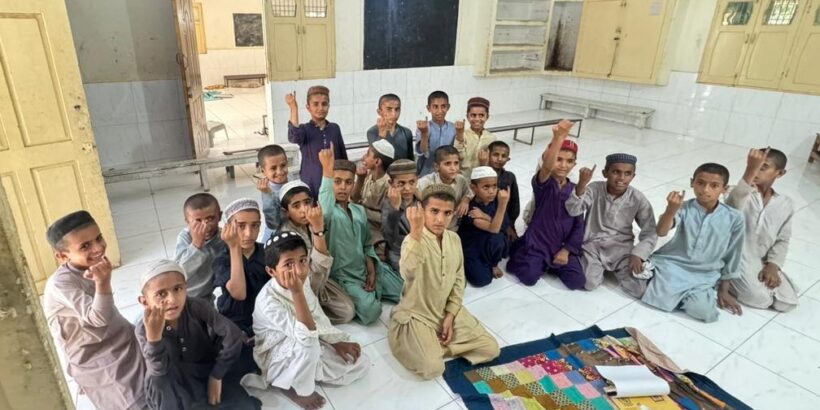A successful immunization campaign depends on several critical elements to achieve the goal of reaching every child with a certain vaccine. Microplans are program documents, created prior to a campaign, that provide vital information for the vaccination teams to accurately count and identify children to be vaccinated, plan sufficient logistics and resources–including human resources–and develop an effective communication strategy.
These microplans, which outline every logistical and operational aspect such as transportation, supply chain management, and workforce deployment, are tools to help ensure all children eligible for a vaccine are identified. By precisely mapping vaccination sites, scheduling daily immunization activities, and using targeted strategies to reach vulnerable and disadvantaged populations, microplans can also be used to identify children who have been previously missed or gone unvaccinated in earlier campaigns.
Identifying eligible children with microplans
Following a significant increase in extensively drug-resistant typhoid cases, the Sindh Expanded Immunization Program (EPI) implemented a typhoid conjugate vaccine (TCV) campaign in May 2024, across eight districts of Sindh Province, Pakistan to vaccinate 9 million children aged 9 months to 15 years who were missed in routine immunization and previous campaigns.
PHC Global worked alongside the Sindh EPI to provide supportive supervision of district staff before, during, and post-campaign. The team reviewed the initial microplans and successfully identified 83,831 missed children who would have gone unvaccinated with TCV if not for a rigorous process that included door-to-door visits. The vaccination teams prioritized reaching zero-dose children – those previously unvaccinated. When a zero-dose child is identified, it helps to update and refine the microplan for that community so that child is not missed during future campaign planning.

Impact of microplans on TCV campaign success
After the campaign concluded, Dilbar Khan, the project manager at PHC Global, reflected on the monumental efforts of the immunization program to deliver on the campaign goal. He also highlighted important topics for robust micro-planning.
Microplans use databases to identify children who need to be reached during a vaccination campaign. A comprehensive database of children can reduce the workload of overburdened health staff and improve campaign efficiency. The technical aspects of the micro-plans often get the most focus and community engagement is not a top priority. As we know from previous campaigns, myriad factors, including misinformation, refusals due to previous adverse reactions to vaccines, and lack of trust in the system pose a challenge to identifying children in a community, thus resulting in children who are not identified and included in the micro-plans. When a child is not included in the microplan, the vaccination team does not know to look for and vaccinate that child, increasing the likelihood that they go unreached. Robust community engagement from the beginning can improve trust and help with identifying children who may otherwise be missed in the microplans and subsequent campaign.
Dilbar believes that microplanning is the backbone of the immunization program. Microplans help to map high-risk areas, plan outreach sessions, and mobilize community influencers to build trust and awareness. PHC Global supported healthcare staff with hands-on training for TCV microplanning, technological tools to digitize data, creating accurate maps, and working with local influencers. “Maps were a significant challenge. We used Google maps to create specific routes to reach hard-to-access and at-risk populations to make the campaign successful,” he added.
He further shared how the PHC Global team recognized that existing traditional methods of microplanning training were inadequate and shifted to hands-on, engaging training sessions. “The health staff appreciated the new approach, which allowed them to provide feedback and engage directly with the planning process. This continuous feedback ensured that microplans were accurate and adaptable to specific needs of the communities” he said.
Community engagement to build trust
Apart from capacity enhancement of the healthcare staff, the PHC Global team engaged local influencers, as “champions” to mobilize the communities. These champions were engaged to raise awareness and reduce vaccine hesitancy based on the information learned through the microplans. Communities with historically low rates of vaccine coverage received messages specific to their circumstance. Initially, PHC Global focused on influencers with significant community impact, but then shifted to individuals who were influential and highly motivated and educated about the cause.
“The aim was not just to succeed in the current campaign but to establish a sustainable process so communities remain connected to the health system for ongoing immunization services,” Khan said, adding that the approach taken by PHC Global sets a precedent for future campaigns, working toward microplanning as holistic, innovative, and driven by communities.
Cover photo: A group of children in Pakistan proudly showing the ink mark on their finger that signals they have been vaccinated with the typhoid conjugate vaccine. Credit: PHC Global.



